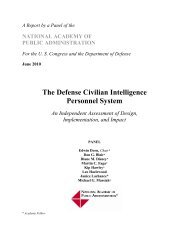Financial Management: Providing a Foundation for Transition - AGA
Financial Management: Providing a Foundation for Transition - AGA
Financial Management: Providing a Foundation for Transition - AGA
- No tags were found...
Create successful ePaper yourself
Turn your PDF publications into a flip-book with our unique Google optimized e-Paper software.
9Table 1:Executives’ rating of internal control ef<strong>for</strong>t integration within their entities(1 = strongly disagree, 4 = strongly agree)Statement1. Internal control ef<strong>for</strong>ts are well integrated across functions such asfinancial management, IT, security, human capital and operations.2. The CFO and other CxOs (or their equivalent) work together tointegrate their internal control ef<strong>for</strong>ts.3. The entity supports the integration of internal controls with an entitywiderisk management approach.Averageagreement rating1.92.02.4This is why some of our executives want to seeAppendix A requirements reduced or at leastkept the same. They think that channelingresources to controls over program and entityper<strong>for</strong>mance and related reporting will deliver abetter return on investment.Integration neededIdeally, an entity will integrate the work ofmanaging and reporting on financial, operationaland compliance controls. Un<strong>for</strong>tunately, surveyresponses to Statements 1 and 2 in Table 1 showthat financial executives have lukewarm opinionsabout internal control integration in theirentities. In the table, a score of 1 means strongdisagreement and 4 means strong agreement.“CxOs” refers to chief in<strong>for</strong>mation officers, chiefhuman capital officers, chief acquisition officersand other chiefs of specific functions.According to some executives, a barrier toimproving the agreement scores in Table 1 is thatCxOs in an entity say they “own” their part ofthe control structure. This stovepipe mentalitygets in the way of controls <strong>for</strong> processes thatcut across organizational boundaries. Everyonehas a role in internal control, and all must worktogether on it.“Don’t stovepipe internal controls. Integrate acrossfunctions—A-123, FISMA, acquisition requirements, HRcontrols. Use A-123 as the framework and add other controlreview requirements into a single framework with onetimeline, one milestone list and one plan.”—An executiveRisk managementStatement 3 in Table 1 is important to the futureof controls, because an entity-wide risk managementapproach leads to setting cross-cuttingpriorities <strong>for</strong> risk mitigation. Many entities, andsometimes the whole national government, lacka sense of priority when it comes to controls.Better risk assessment and a focus on managingrisk would make control activities less costly and













